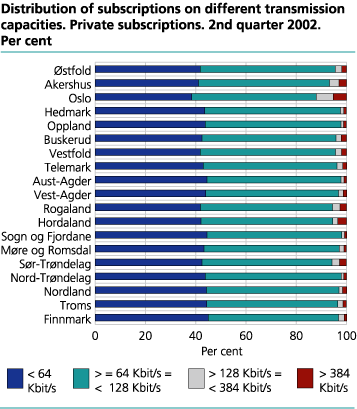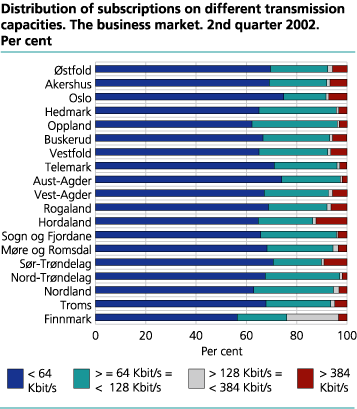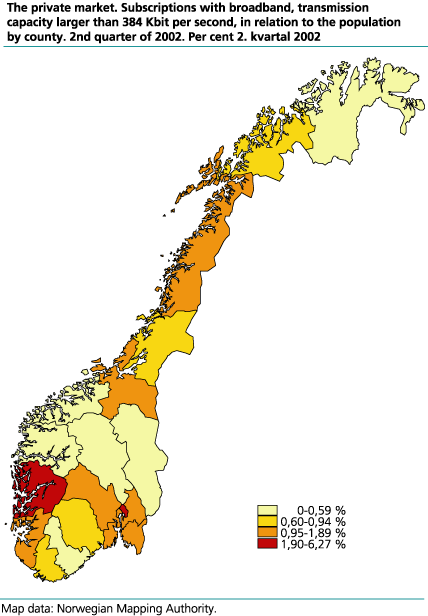Content
Published:
This is an archived release.
25 000 more broadband subscriptions
By the end of the 2nd quarter of 2002 there were almost 77 000 broadband subscriptions via cable, ADSL, etc. Corresponding figures for the 1st quarter were about 51 000. Internet subscriptions with less transmission capacity made up about 90 per cent of all subscriptions.
One out of four new Internet subscriptions in the 2nd quarter was a broadband subscription. Broadband subscriptions increased by 50 per cent compared with the 1st quarter while subscriptions with lower transmission capacity only increased by 3 per cent. However, it is subscriptions with an Internet connection via analogue modem and ISDN that make up most of the subscriptions with 44 per cent and 51 per cent respectively.
In this survey broadband is defined as Internet subscriptions with a transmission capacity (rate of speed inn) larger than 384 Kbit per second.
Most broadband in towns
Counties with densely populated areas have the highest number of broadband for both private and business subscriptions. There were fewer subscriptions with this transmission capacity in counties with sparsely populated areas. The geographical distribution of broadband is among other things connected with the possibility of taking advantage of technologies like cable, ADSL, etc.
Three million Internet subscriptions
The total number of Internet subscriptions amounted to about 158 000 business subscriptions and 2.7 million private subscriptions. In relation to the 1st quarter this implies an increase of 13.5 per cent for business subscriptions and 3.2 per cent for private subscriptions. Subscription figures also include those that have not been used during the last quarter. Among subscriptions with analogue modem and ISDN there is particularly many inactive subscriptions.
Both private persons and businesses can have several Internet subscriptions and it is similarly possible for several private persons to use the same subscription. Therefore the number of subscriptions is not the same as the number of persons/businesses with Internet access.
The figures are based on data from suppliers of Internet access. We want to stress that figures for the 1st quarter have been revised since the publication on 26 June 2002. These statistics will later on include variables that describe Internet usage. It is an objective to publish figures on a more detailed regional level. For more information see "About the Statistics".
Tables:
- Table 1 Private Internet subscriptions. Subscription by transmission capacity and county. 2nd quarter 2002
- Table 2 Business Internet subscriptions. Subscription by transmission capacity and county. 2nd quarter 2002
- Table 3 Private Internet subscriptions. Development features. Subscription by transmission capacity and county. 1st and 2nd quarter 2002
- Table 4 Business Internet subscriptions. Development features. Subscription by transmission capacity and county. 1st and 2nd quarter 2002
Contact
-
Statistics Norway's Information Centre
E-mail: informasjon@ssb.no
tel.: (+47) 21 09 46 42



